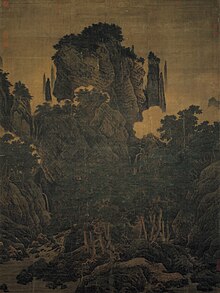Li Tang
Li Tang (* around 1050 in Henan , † around 1130 in Hangzhou ) was a painter of the Song Dynasty . He is considered one of the most important landscape painters of the Song dynasty, as he is a link between the painting schools of the northern and southern Song and established the so-called fu pi cun drawing technique ( ax-cut texture stroke ).
Life
Little is known about Li Tang's life. It is known that he was born around 1050 in Henan Province. He later moved to Kaifeng , the then capital of Northern Song. The first date recorded for him is an order from the year 1103 to copy a picture from the Tang Dynasty . During the reign of Emperor Huizong (1100-1125) he became a member of the imperial painting academy and rose to its director. After the collapse of the northern Song and the conquest of Kaifeng by the Jurchen , Li Tang fled to Hangzhou in southern China. There he had to stay afloat by selling drawings until he got a job under the first emperor of the southern Song, Gaozong (1127–1162), in the new painting academy at the court in Hangzhou and became one of the emperor's favorite painters .
plant
Li Sixun , one of the most famous painters of the Tang dynasty , was probably one of Li Tang's models . It is said that Emperor Gaozong, whose favorite painter was Li Tang, compared him to Li Sixun. Li Tang represents a link between painting schools of the northern and southern Song dynasties and, not least through the fu pi cun drawing technique he developed , he influenced numerous later painters up to the Ming dynasty in China and the Edo period in Japan. These include Xia Gui and Ma Yuan and the Ma-Xia school of the southern Song founded by them, as well as the Japanese Sesshū Tōyō (1420-1506).
Knowledge of Li Tang's work is essentially based on descriptions in historical sources and later painters who copied his works or adapted his style. Most of the original works were probably destroyed during the conquest of Kaifeng and there are only a few surviving works that can be ascribed to him, but their authenticity is not entirely certain. These include the landscape painting Wind in Pines Among a Myriad Valleys (dt. Wind in the pine trees in 1000 valleys ) of the National Palace Museum in Taiwan and two landscapes in the Kōtō-in (part of the Daitoku-ji temple complex) in Japan.
literature
- Richard Edwards: The Landscape Art of Li T'ang . Archives of the Chinese Art Society of America, Volume 12, 1958, pp. 48-60 ( JSTOR )
- Richard Barnhart: Li T'ang (c.1050-c.1130) and the Kōtō-In Landscapes . The Burlington Magazine, Volume 114, No. 830, May 1972 (Special Edition on Chinese Landscape Painting), pp. 304-311, 313-314 ( JSTOR )
- Dorothy Perkins: Encyclopedia of China: History and Culture . Routledge, 2013, ISBN 9781135935627 , p. 280 ( excerpt (Google) )
Web links
- Li Tang in the Encyclopedia Britannica
Individual evidence
- ^ A b Richard Edwards: The Landscape Art of Li T'ang . Archives of the Chinese Art Society of America, Volume 12, 1958, p. 48
- ^ A b c Dorothy Perkins: Encyclopedia of China: History and Culture . Routledge, 2013, ISBN 9781135935627 , p. 280 ( excerpt (Google) )
- ↑ Richard Barnhart: Li T'ang (c.1050-c.1130) and the Kōtō-In Landscapes . The Burlington Magazine, Volume 114, No. 830, May 1972 (Chinese Landscape Painting Special), p. 309 ( JSTOR )
- ^ Edwards, p. 58
| personal data | |
|---|---|
| SURNAME | Li Tang |
| BRIEF DESCRIPTION | Chinese painter |
| DATE OF BIRTH | around 1050 |
| PLACE OF BIRTH | Henan |
| DATE OF DEATH | around 1130 |
| Place of death | Hangzhou |

